 |
 |
| Home | Welcome | What's New | Site Map | Glossary | Weather Doctor Amazon Store | Book Store | Accolades | Email Us |
 | |||||||||||
Weather Almanac for September 2003ERIC SLOANE: LOOK AT THE SKYA while back, I had the opportunity to address a group of British Columbia school teachers. In one of the other presentations, the speaker, a high school teacher showed us an overhead presenting an illustration that he felt was ideally designed for his students to grasp weather concepts. He enthusiastically informed us that he had found it in a previously classified, World War II instruction manual for US military pilots, but he did not know the illustrator's name. I knew the minute the slide went up, before he had even mentioned its anonymity: it was a work of Eric Sloane. Had the teacher been a few decades older, he may have known that this was a Sloane work. Growing up in the Fifties and Sixties I found Sloane's weather books, and in my essay The Weather Doctor's Classic Weather Books, I list three books among the early influences on my choice of study and career. I checked these books out of the school and village libraries with great frequency — often the only reader of them — but did not own one until my university days. 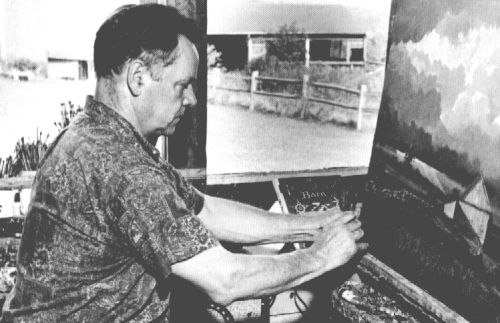 Eric Sloane at work painting Cloud Symphony |
|||||||||||
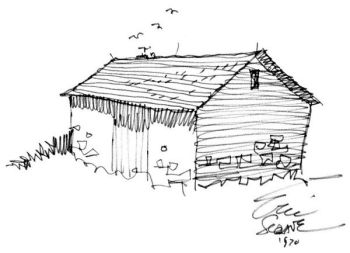 | 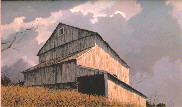 |
Eric Sloane was not born on February 27, 1905 in New York City, Everard Jean Hinrichs was. Hinrichs assumed the pseudonym while studying art. He tells us in I Remember America that the name arose spontaneously while listening to a luncheon conversation between artists George Luks and John Sloan on recognition. As he sketched the pair, they suggested young artists paint under an assumed name in their early years while they perfected their style and craft so that early inferior works would not be attached to them. Since "Hinrichs" was a hard name to remember and usually mispronounced, Everard signed the sketch "Eric Sloan" then added an "e" just to be different. "Where the 'Eric' came from, I don't recall...," he wrote later. (Exactly when he started using Eric Sloane is unclear, but he appears to have followed his mentor's advice and used both names for some time before finally adopting his chosen name exclusively.)
Hinrichs was born into "a home of the least artistic taste" which by his own admission helped his budding interest in art at first. "One advantage of my having been raised in an inartistic family was that no one accused me of having talent; that sort of thing often frightens otherwise creative children into becoming business people." While his family had no interest in his art, he was fortunate to spent time with Long Island neighbour Fred Gaudy, designer of the Gaudy type style, from whom he learned to paint signs. He enrolled for classes at New York's Art Students League (where the encounter with Sloan and Luks occurred).
Hinrichs left home at age nineteen to travel America as an itinerant sign painter. From Bull Durham and Red Man Tobacco highway signs to café windows in New Orleans, he eventually lettered his way across the nation until he reached Taos, New Mexico in 1924. In the southwest desert, vivid skies impressed the young painter, as he would later recall.
"Quiet seemed in tune with the wind that haunted the high places like a hymn, and I felt as though I constantly walked in an atmospheric cathedral. The provocative landscape and overwhelming skyscapes stirred my emotion into a spiritual experience and wherever I looked there was a meaningful picture to be painted. It was there and then I decided to make painting my life work and to make the sky my theme."
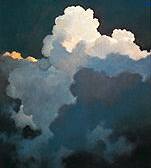 Returning to New York around 1933, Sloane found work as a muralist at Coney Island Amusement Park. The
Half Moon Hotel, the nearest hotel to busy Roosevelt Field, also hired him to decorate its walls with murals.
Since the hotel's lounge and restaurant were frequented by aircraft mechanics and pilots, he gave the
restaurant walls an aviation motif. These murals led to assignments from several pioneer aviators as an
"aviation artist," as his first business card read, painting identifying markings on their aircraft and portraits of
their airplanes. Among those who sought his services was Amelia Erhardt, who would buy his first solely
cloud painting, Charles Lindbergh, and Wiley Post. Post taught him to fly in exchange for art lessons.
Returning to New York around 1933, Sloane found work as a muralist at Coney Island Amusement Park. The
Half Moon Hotel, the nearest hotel to busy Roosevelt Field, also hired him to decorate its walls with murals.
Since the hotel's lounge and restaurant were frequented by aircraft mechanics and pilots, he gave the
restaurant walls an aviation motif. These murals led to assignments from several pioneer aviators as an
"aviation artist," as his first business card read, painting identifying markings on their aircraft and portraits of
their airplanes. Among those who sought his services was Amelia Erhardt, who would buy his first solely
cloud painting, Charles Lindbergh, and Wiley Post. Post taught him to fly in exchange for art lessons.
During his first flights with Post, Eric fell in love with the aerial view of sky and clouds that lay beneath him. "Some day," Post told him, "a fellow will come along and paint nothing but the sky itself. Where else can you find higher mountains? Look at the cumulonimbus over yonder — twice the height of the Matterhorn and twice as beautiful. Where else but up here could you see a better landscape of clouds." Sloane remembers replying: "What you mean is a cloudscape, and I wouldn't be surprised if the first fellow to try painting cloudscapes turns out to be me."
In deciding to focus on cloudscapes, Sloane felt he must first learn what the sky was all about. His chosen method for learning was to write a book about the subject. His first book Clouds, Air and Wind, published in 1941, was adapted by the US Army Air Corps as a basic weather manual for pilots (likely the source of that teacher's overhead!). The US War Department hired him for additional wartime illustration projects including a book on the theory and practice of camouflage.
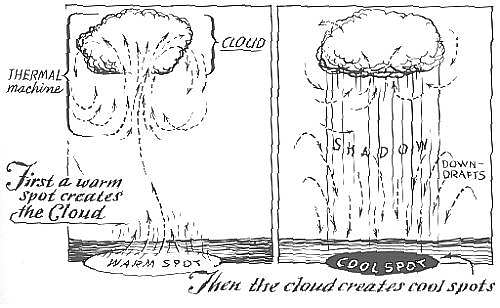
On a research trip to New York's American Museum of Natural History, Sloane was dismayed to discover no "Hall of Atmosphere," which he thought was the basis for all natural history. Sloane vowed to design one. With encouragement and backing from a neighbour, William Willetts, who was looking for a memorial to his son Prentice, killed in an air accident, Sloane began to work on the project.
He transformed the Willetts' squash court into a studio workshop and began building animated three-dimensional models of clouds, cold fronts, war fronts, hurricanes and other weather phenomena. This business venture went by the name of Airology Workshop, because he thought "meteorology" too confusing a word. With Willetts' financial backing and support from museum head Trubee Davison, Sloane's glass-encased models — that simulated lightning, rain and winds — were installed as the Willetts Memorial Hall of Atmosphere in the American Museum of Natural History.
Sloane tried formal study of meteorology at the Massachusetts Institute of Technology but the mathematical requirements left him cold. In Look At the Sky, he recalled:
"I could never get to 'see' atmosphere as a tangible material just by reading about it in meteorology books or by analyzing it in mathematical formulae. But once I became introduced to the sky and to that lower part of the sky which I live in, my life became very much richer. ... I have tried to be both meteorological and philosophical about the sky, but I constantly find its spiritual qualities outweighing its weather influences. I believe that the sky was created for pure beholding; that one of man's greatest pleasures can be simply looking at the sky."
According to biographer Jim Mauch (Aware), one of Sloane's professors quipped that if Sloane wanted romance in weather he would not find it at MIT and suggested reading the almanacs and weather diaries of early New England farmers. The suggestion was taken by Sloane, and serendipitously, a whole new avenue of interest was born.
In the lore of early American farmers and others, Sloane found folks attuned not only to weather but to the rhythms of life. In their daily routines, he discovered a new appreciation for the ways and means of life in that period. This lead to growing interests in early American tools, barns and other structures, for which he is best remembered today. In addition to his many books and paintings on topics of early Americana, Sloane collected examples of those early tools that lead to the establishment of the Sloane-Stanley Museum in Kent, Connecticut in 1969.
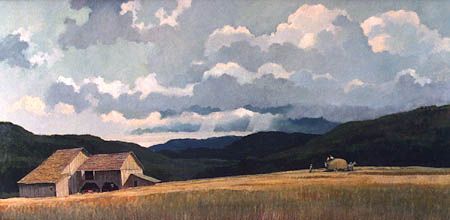
Though his interests took a fork in the road, Sloane never left cloudscapes and weather. Combining weather forecasting with his interest in early American weather lore, Eric convinced Dumont, a New York-based television network, to produce a regular weather segment with him reporting weather observations from New England farmers to a regional audience. Some consider him the first television weatherman. (Since I cannot find a year for this endeavour, I will hold judgement on who was technically first. Many feel Chicago's Clint Youle in 1947 is the first.)
His final years were spent working on paintings, writing books and perfecting the Sloane-Stanley Museum., splitting his time between homes in Taos, New Mexico and Cornwall, Connecticut. Shortly after completing his last book Eighty, An American Souvenir, and less than a week after his eightieth birthday, Sloane fell dead from a heart attack while on his way to lunch with his wife.
By most accounts, Eric Sloane produced a prodigious body of work over his lifetime. He created an estimated 15,000 paintings, mostly oil on masonite, often painting one a day — often before lunch. (My favourite painting is titled Cloud Symphony, a copy of which adorned my living rooms for many years. It is said that he often purchased older works he was disappointed with and burned them. He also wrote thirty eight books (excluding collections and anthologies to which he contributed). Sloane's books focused solely on weather are (year of first edition):
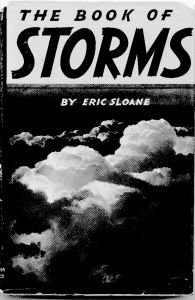
I also place his The Seasons of America Past (1971) as a cousin to the above as it looks at the seasons from both a weather and social viewpoint. Unfortunately, all of the above books appear to be out of print. (Only a few books are currently listed at Amazon.com as new, though it appears that some of his works are being reprinted by Dover Publications; many titles are available used through their Marketplace — and often cheaper than new editions.)
Sloane's largest, and perhaps most viewed work was painted in 1976, a large, L-shaped mural on the west lobby wall of the Smithsonian Air and Space Museum in Washington, DC. Entitled Earth Flight Environment, it depicts a panoramic view of a western landscape as a lone airplane streaks across the sky. The 75 feet by 58 feet, 6 inches work changes from realistic to symbolic as Sloane's renditions of lightning, rain, a rainbow, and assorted cloud formations ascend toward a rocket airplane entering the aurora borealis and outer space. The mural is bordered on its lower frame with a variety of weather map symbols.
Why do I dedicate The Weather Doctor to Eric Sloane? The ease of reading of his weather books had a profound influence on my choice of meteorology as a career and the nature of my writing style. My teenage interest in folklore also grew from Sloane's work on weather sayings (as did an adult interest in early Americana). Of the five men to whom this site is dedicated, he had the first impacts on me — during grade school — while I would not discover the others until high school or college.
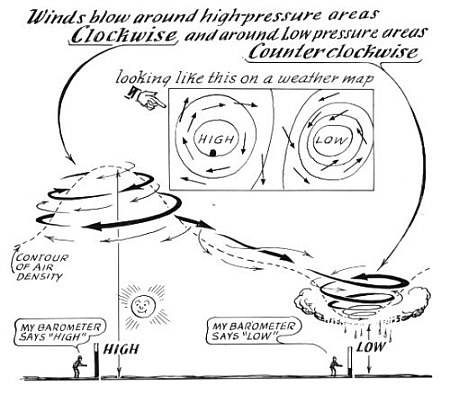
Eric Sloane wrote with a clarity of style that was as crisp as his paintings. I have garnered many "words of wisdom" from his writings, some of which are presented on this site within The Elders Speak pages, one of which collects some of his best quotations: Eric Sloane on Weather.
I close with a quote from his book Look At The Sky ... And Tell The Weather, specifically the last two lines of
the book:
"Get friendly with your neighborhood weather — you'll find him good company. Look at the sky and tell the
weather."
 |
To Purchase Notecard, |
Now Available! Order Today! | |
 |
 |
NEW! Now |
The BC Weather Book: |


